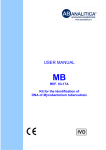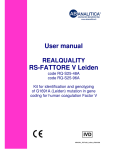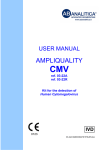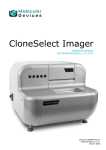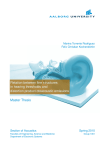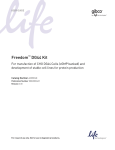Download USER MANUAL
Transcript
USER MANUAL γTCR Kit for the analysis of clonality of V-J regions of γ-chain of T-cell receptor (TCR) REF. 04-60A 04-60R-50(8033622780731)-EN.doc 1. KIT CONTENT 3 2. STORAGE AND STABILITY OF THE REAGENTS 4 3. PRECAUTIONS FOR USE 4 4. SAFETY RULES 5 4.1. General safety rules 5 4.2. Safety rules about the kit 6 5. MATERIALS REQUIRED, BUT NOT PROVIDED 7 5.1 Reagents 7 5.2 Instruments 7 5.3 Materials 7 6. PREPARATION OF THE REAGENTS 8 7. INTRODUCTION 9 8. TEST PRINCIPLE 12 10. COLLECTION, MANIPULATION AND PRE-TREATMENT OF THE SAMPLES 14 10.1. Peripheral or bone marrow blood 10.1.1. Pre-treatment of peripheral or bone marrow blood 14 14 10.2. Histological samples 10.2.1. Pre-treatment of histological samples 14 15 11. 16 11.1. PROTOCOL DNA EXTRACTION 16 11.2. γ CHAIN V-J REGION DNA AMPLIFICATION 11.2.1. Synthesis of a single strand DNA 11.2.2. TCR γ CHAIN V-J REGION ssDNA AMPLIFICATION pag. 1 04-60R-50(8033622780731)-EN.doc 17 17 18 11.3. VISUALIZATION OF THE AMPLIFICATION PRODUCTS 11.3.1. Agarose gel electrophoresis 11.3.2. Sample loading 19 19 19 11.4. 21 INTERPRETATION OF THE RESULTS 12. TROUBLESHOOTING 23 13. DEVICE LIMITS 25 14. DEVICE PERFORMANCES 25 14.1. Specificity 25 14.2. Sensitivity 25 15. BIBLIOGRAPHIC REFERENCES 26 16. INFORMATION FOR ORDERS 27 16.1. RELATED PRODUCTS 28 pag. 2 04-60R-50(8033622780731)-EN.doc 1. KIT CONTENT BOX P STORE AT – 20°C COLOUR OF TUBE (T) OR LID 25 test 50 test 8 test MM1 monodose premix tubes Colourless(T) 25 50 10 MM2 monodose premix tubes Green(T) 25 50 10 Red 1 x 25 μL 1x 50 μL 1 x 10 μL DESCRIPTION Thermostable Taq DNA polymerase LABEL AB TAQ 5 U/μL SMALL BAG Plasmid DNA obtained from monoclonal T cells STORE AT – 20°C Positive control γTCR Blue BOX F 1 x 30 μL 1 x 50 μL 1 x 10 μL STORE AT +2°/+8°C Electrophoresis Buffer for sample loading Blu 6X Blue 1 x 150 μL 1 x 300 μL 1 x 100 μL Ethidium Bromide solution (2,5 mg/mL) Ethidium Bromide Red 1 x 80 μL 1 x 150 μL 1 x 50 μL Yellow 1 x 80 μL 1 x 150 μL 1 x 50 μL DNA Molecular Weight Marker Toxic R 23 68 S 36/37 45 MW Marker STORE AT +15°/+25°C BOX A Agarose for molecular biology Electrophoresis Buffer TRIS-Borate-EDTA pH: 8,00 AGAROSE 1 x 10 g 1 x 20 g 1x5g TBE 50X 1 x 250 mL 1 x 500 mL 1 x 100 mL pag. 3 04-60R-50(8033622780731)-EN.doc 2. STORAGE AND STABILITY OF THE REAGENTS Each component of the kit should be stored according to the directions indicated on the label of the single boxes. In particular: Box P Small bag Box F Box A store at -20°C store at -20°C store at a +2/+8°C store at +15 / +25°C When stored at the recommended temperature, all test reagents are stable until their expiration date. 3. PRECAUTIONS FOR USE • The kit should be handled by investigator qualified through education and training in molecular biology techniques applied to diagnostics; • Before starting the kit procedure, read carefully and completely the instruction manual; • Keep the product out of heating sources; • Do not use any part of the kit if over the expiration date; • In case of any doubt about the storage conditions, box integrity or method application, contact AB ANALITICA technical support at: [email protected] . In the amplification of nucleic acids, the investigator has to take the following special precautions: • Use filter-tips; • Store the biological samples, the extracted DNA, positive control included in the kit and all the amplification products in different places from where amplification reagents are stored. pag. 4 04-60R-50(8033622780731)-EN.doc • Organise the space in different pre- and post-PCR units; do not share consumables (pipets, tips, tubes, etc) between them. • Change the gloves frequently; • Wash the bench surfaces with 5% sodium hypochloride; • Thaw the PCR premixes at room temperature before use. Add the Taq DNA polymerase and purified DNA very quickly at room temperature or in an ice-bath. 4. SAFETY RULES 4.1. General safety rules • Wear disposable gloves to handle the reagents and the clinical samples and wash the hands at the end of work. • Do not pipet with mouth. • Since no known diagnostic method can assure the absence of infective agents, it is a good rule to consider every clinical sample as potentially infectious and handle it as such. • All the devices that get directly in touch with clinical samples should be considered as contaminated and disposed as such. In case of accidental spilling of the samples, clean up with 10% Sodium Hypochloride. The materials used to clean up should be disposed in special containers for contaminated products. • Clinical samples, materials and contaminated products should be disposed after decontamination by: immersion in a solution of 5% Sodium Hypochloride (1 volume of 5% Sodium Hypochloride solution every 10 volumes of contaminated fluid) for 30 minutes OR autoclaving at 121°C at least for 2 hours (NOTE: do not autoclave solutions containing Sodium Hypochloride!!). pag. 5 04-60R-50(8033622780731)-EN.doc 4.2. Safety rules about the kit The risks for the use of this kit are related to the single components: Dangerous components: 3,8-diamino-1-ethyl-6-phenylphenantridiumbromide (Ethidium Bromide) <2% Description of risk: T (Toxic) RISK SENTENCES AND S SENTENCES ETHIDIUM BROMIDE R 23 and R 68 S 36/37 45 Toxic for inhalation. Risk of irreversible effects. Wear laboratory coat and disposable gloves. In case of accident or discomfort, seek for medical assistance and show the package label. R and S sentences refer to the concentrated product, as provided in the kit. In particular, for Ethidium Bromide, until the dilution in the agarose gel. In manipulating concentrated Ethidium Bromide, use a chemical dispensing fume cabinet. Always wear disposable gloves and laboratory coat in manipulating the diluted Ethidium solution as well. The product can not be disposed with the common waste. It must not reach the drainer system. For the disposal, follow the local law. In case of accidental spilling of Ethidium Bromide, clean with Sodium hypochloride and water. Safety data sheet (MSDS) of Ethidium Bromide is available upon request. pag. 6 04-60R-50(8033622780731)-EN.doc 5. MATERIALS REQUIRED, BUT NOT PROVIDED 5.1 Reagents • Sterile DNase and RNase free water; • Distilled water. 5.2 Instruments • Laminar flow cabinet (use is recommended while adding TAQ polymerase to the amplification premix to avoid contamination; it would be recommended to use another laminar flow cabinet to add the extracted DNA); • Micropipettes (range: 0,2-2 µL; 0,5-10 µL; 2-20 µL); • Thermalcycler; • Microcentrifuge (max 12.000-14.000 rpm); • Balance; • Magnetic heating stirrer or microwave; • Chemical cabinet (use is recommended in handling Ethidium Bromide); • Horizontal electrophoresis chamber for agarose minigel; • Power supply (50-150 V); • UV Transilluminator; • Photo camera or image analyzer. 5.3 Materials • • • • • Disposable gloves; Disposable sterile filter-tips (range: 0,2-2 µL; 0,5-10 µL; 2-20 µL;); Graduate cilinders (1 L) for of TAE dilution; Pyrex bottle or Becker for agarose gel preparation; Parafilm. pag. 7 04-60R-50(8033622780731)-EN.doc 6. PREPARATION OF THE REAGENTS Preparation of 1 L of 1X TAE buffer: • Mix 200 mL of 5X TBE with 800 mL of distilled water. pag. 8 04-60R-50(8033622780731)-EN.doc 7. INTRODUCTION The lymphoid diseases include malignant lymphoma (non-Hodgkin lymphoma and Hodgkin disease) and the chronic lymphoid leukaemia (Harris et al., 1994). In the diagnosis of these pathologies the molecular techniques (Southern blot and Polymerase Chain Reaction) are becoming more popular. Their applications are in the diagnosis of complete or partial disease remission and in monitoring the minimal residual disease (MRD). A correct diagnosis of haematological diseases needs a multidisciplinary approach, that allows to correlate the traditional morphological evaluations (Hematoxylin-eosin stain or Wright) with a variety of special analysis, like immuno-histochemical staining, molecular and cytogenetic techniques. Lymphoid diseases are an heterogeneous group of diseases that result as the consequence of a B and T lymphocytes neoplastic transformation in different phases of their development. Their big variety is related to lymphocytes diversity during the different phases of their development and to the huge complexity of the immune system. Since the DNA rearrangements take place in great numbers during T cells development, T cells tumours are very frequent. As for B cells tumours, T cells tumours are related to different development phases. While B cells tumours are referred to the entire phase of B cells development, T cells tumours correspond to the precocious and latest stadiums of it, the lack of involvement of the intermediate stadiums of development could be due to the fact that immature T cells, if not rescued in a short time after the successive positive maturation, are programmed for cellular death. In these circumstances, there is not sufficient time for tymocites to accumulate enough mutations for malignant transformation (Zucchini A. et al. 2002). The availability of molecular techniques has allowed not only the increase of the capacity to diagnose the diseases, but also the possibility of a correct classification of them (Cossman et al., 1998). The most important application of molecular methods in lymphoid diseases evaluation is the determination of cell clonality. These techniques are considered as the “gold standard” for the clonality determination and are used when this information can not be obtained by the immuno-pathologic techniques, mostly for lymphoid diseases of T-origin. The molecular method allows to evaluate if the lymphoid abnormality is due to a neoplastic process, therefore to a monoclonal proliferation, or to a reactive benignant process, to which polyclonal proliferation is associated. pag. 9 04-60R-50(8033622780731)-EN.doc Since a neoplasy is the result of an unlimited growth of a single cell, all the cells of a T-cell cancer have the same rearranged TCR genes (T-Cell Receptor). The TCR, or T -Cell Receptor, is an hetherodimeric glycoprotein characterised by 4 distinct chains, α, β, γ and δ, expressed as heterodimers α / β or γ / δ. The aminoacidic sequence analysis of the heterodimers revealed a surprising analogy between TCR structural dominium and those relating to the Immunoglobulin (Ig); this fact leads to consider the TCR as a member of the Ig superfamily. ANTIGEN RECOGNITION BY T LYMPHOCYTES T TCR α/β γ/δ Ag MHC APC As for the Ig genes, the TCR variable dominium is produced as a result of the rearrangements of V (variable) and J (Joining) segments in the α and γ families chains and of the V, D (diversity) and J segments in the β and γ families chains; these regions are flanked by the constant (C) respective genic segments. In particular, the dominium nearest to the membrane is constant , while the dominium far from the membrane is variable and contains the antigen binding site. γ -chain rearrangement V genes V1 V2 J1 genes V3 C1genes Vn J2 genes C2 genes C C germline DNA rearrangement V1 V2 V3 J2 C2 pag. 10 04-60R-50(8033622780731)-EN.doc Most of T lymphocytes expresses the α / β heterodimers: the T lymphocytes percentage with α / β or γ / δ varies in the different organs and from specie to specie; in man, the most of mature T cells located in the peripheral blood expresses the α / β TCR, while T cells expressing γ / δ TCR are in a little amount: from 1 % to 5 %. The complete and functional TCR is joined to CD3, a signal transduction molecular complex. This structure is involved in the antigenic acknowledgment, only after the antigen has been processed by an antigen presenting cell (APC). Before being recognised by T lymphocytes, the antigen has to be fagocitated or endocytated by the APC and processed in little peptides. Antigen fragments are then presented to TCR in the context of the products of I and II class Major Histocompatibility Complex (MHC), that are constitutively expressed on the accessory cells membrane. The contact between TCR and its specific antigenic determinant leads to the internalisation of the CD3 molecule. The analysis of the TCR gene rearrangements by molecular biology techniques allow to detect the neoplastic nature of T cells expansions. It is not possible instead to demonstrate the clonal nature of NK cells leukaemia, whose diagnosis is done only on the basis of morphological, immuno-phenotypic and clinical analysis. pag. 11 04-60R-50(8033622780731)-EN.doc 8. TEST PRINCIPLE PCR method (Polymerase Chain Reaction) has been the first method of DNA amplification described in literature (Saiki RK et al., 1985). It can be defined as an in vitro amplification reaction of a specific part of DNA (target sequence) by a thermostable DNA polymerase. Three nucleic acid segments are involved in the reaction: double stranded DNA template to be amplified (target DNA) and two single-stranded oligonucleotides “primers” that are designed in order to anneal specifically to the template DNA. The DNA polymerase begins the synthesis process at the region marked by the primers and synthesizes new double stranded DNA molecules, identical to the original double stranded target DNA region, by facilitating the binding and joining of the complementary nucleotides that are free in solution (dNTPs). After several cycles, one can get millions of DNA molecules which correspond to the target sequence. The sensitivity of this test makes it particularly suitable for the application in laboratory diagnostics. Moreover, the amplification reaction can be executed from a wide range of biological samples and since it allows to amplify very small DNA fragments, the starting DNA can be also partially degraded. pag. 12 04-60R-50(8033622780731)-EN.doc 9. PRODUCT DESCRIPTION The molecular strategy adopted in this kit for detecting T cells monoclonality is characterised by the use of consensus primers for the V and J regions of the TCR γ chain. TCR γ chain analysis is the simplest and most efficient method to study TCR gene rearrangements. In effect, with reference to β chain, the number of gene segments of γ chain coding locus is reduced and moreover, γ genes rearrangements are present in most of neoplastic and normal T lymphocytes. The TCR gene rearrangement takes place in a precocious stadium of T differentiation and, particularly, γ / δ rearrangement precedes that of α / β chains. The ssDNA (single strand DNA) synthesis followed by γ chain V-J regions amplification guarantees to the method the necessary sensitivity for its application in the T-cells monoclonality study. The revelation of the amplified fragment is performed by a high resolution agarose gel electrophoresis. The different aspects of the amplified products allow to discriminate a monoclonal sample from an oligoclonal or polyclonal sample. The kit also provides with positive control of amplification. When the amplification of the positive control is successful, it is guaranteed that the reaction is correct. These controls are not dangerous for the operator because they are plasmid DNA containing only the V-J region of the γ chain, obtained from monoclonal T cells. The kit is in premix format: all the reagents for the amplification are pre-mixed and aliquoted in monodose test tubes (0,2 or 0,5 mL) to which Taq polymerase and the extracted DNA will be added. This premix format allows the reduction of the manipulation steps in pre-amplification, with considerable time saving for the operator; the repeated freezing/thawing of reagents (that could alter the product performances) is avoided and, above all, this form minimizes the risk of contamination, so the risk to get false positive results. Nevertheless, it’s always recommended to use all the proper amplification controls. The MM1 premixes include a wax bead; this bead will allow to perform a hot start amplification during ssDNA amplification: the Taq DNA polymerase becomes active only after the initial denaturation step, when the wax melt will allow its descending in the mix. The hot start amplification reduces the possibility of an eventual presence of unspecific amplified products. pag. 13 04-60R-50(8033622780731)-EN.doc 10. COLLECTION, MANIPULATION AND PRETREATMENT OF THE SAMPLES 10.1. Peripheral or bone marrow blood During the sample collection, follow all the usual sterility precautions. Blood should be treated with EDTA. Other anticoagulating agents, as heparin, are strong inhibitors of TAQ polymerase and so they could alter the efficiency of the amplification reaction. Fresh blood can be stored at +2/+8°C and processed in a short time; if DNA extraction is not performed in a short time, the sample must be frozen. 10.1.1. Pre-treatment of peripheral or bone marrow blood In order to obtain a more appreciable yield in the DNA extraction, it is recommended to prepare a buffy coat by centrifuging the whole blood at 3300 x g, for 10 min at room temperature. Then, three different fractions will be distinguishable: the plasma is the clear upper fraction; the buffy coat is the intermediate fraction, containing the concentrated leucocytes, and the remaining fraction contains the erythrocytes. Alternatively, it is also possible to perform a FICOLL protocol in order to isolate a pellet of white cells. 10.2. Histological samples Histological samples include fresh, frozen or formalin-fixed and paraffinembedded biopsies. The fresh biopsy could be treated, within few minutes from sampling, or quickly frozen with liquid nitrogen and successively stored at -80°C until mechanic disruption by using sterile cutter, followed by enzymatic digestion with Proteinase K. In case that the biopsy is fixed and paraffin-embedded, it is suggested the use of formalin buffer at pH 7 with sodium and potassium salts at 10%, as Lilie formula. Tissue fixation with not-buffered formalin in Bouin, Holland or other acidic fixatives (osmic acid, for instance) is not suitable for subsequent DNA extraction because those substances produce cross-links in the tissue, making it not-digestible. pag. 14 04-60R-50(8033622780731)-EN.doc 10.2.1. Pre-treatment of histological samples In case of fresh or frozen histological sample (up to 50 mg), proceed quickly with mechanic disruption of the sample by a sterile cutter. Do this operation on a glass slide, transfer the minced tissue in a tube, then proceed with digestion with Proteinase K. In case that the biopsy is fixed and paraffin-embedded proceed first with paraffin removal and then with sample digestion. pag. 15 04-60R-50(8033622780731)-EN.doc 11. PROTOCOL 11.1. DNA EXTRACTION For DNA extraction, any extraction method can be used, provided that it allow to isolate an integral and pure DNA. The obtained DNA should be quantified by photometric measures. The DNA amount to use in the amplification is 500 ng and, if necessary, the obtained solution should be diluted. Please note that the required volume of extracted DNA to be added in each premix tube is 10 μL. For any further information contact AB ANALITICA technical support e-mail: [email protected] pag. 16 04-60R-50(8033622780731)-EN.doc 11.2. 11.2.1. γ CHAIN V-J REGION DNA AMPLIFICATION Synthesis of a single strand DNA Add into each MM1 colourless test tube (containing 9.9 μL of mix and a wax bead): 0,1 μL 5* μL 5 μL AB Taq Extracted DNA Sterile water It is important to include in each experiment a negative polyclonal control to monitor the contamination (any genomic DNA of a healthy patient) and 10 μL of a monoclonal positive control (included in the kit). Moreover, the introduction of a negative amplification control (water instead of DNA) will allow to monitor the contaminations. *The ideal amount of DNA to amplify is 500 ng. It is suggested to verify the extracted DNA concentration by photometric measures. In particular, for DNA extracted from paraffin-included specimen, it could be necessary to amplify a DNA sample bigger that 5 μL: in this case, the volume of sterile water in the reaction mix can be diminished. Centrifuge briefly, then incubate the tubes in the termalcycler programmed as below: 1 cycle 94°C 5 min 94°C 30 sec 55°C 45 sec 73°C 45 sec 1 cycle 73°C 5 min storage 4°C 25 cycles Proceed directly with the ssDNA amplification. pag. 17 04-60R-50(8033622780731)-EN.doc 11.2.2. TCR γ CHAIN V-J REGION ssDNA AMPLIFICATION Add to each green MM2 test tube: 0,1 μL AB Taq Put the obtained mix (21 μL) in the MM1 tubes, over the wax stratum, paying attention not to damage it. Centrifuge shortly and put the test tubes in the thermalcycler programmed as below: 1 cycle 94°C 5 min 94°C 30 sec 55°C 45 sec 73°C 45 sec 1 cycle 73°C 7 min storage 4°C 30 cycles Amplification fragments length is in the range from 160 bp to 190 bp. pag. 18 04-60R-50(8033622780731)-EN.doc 11.3. 11.3.1. VISUALIZATION OF THE AMPLIFICATION PRODUCTS Agarose gel electrophoresis Preparation of a 3% agarose gel: Weight 1,5 g of HR Agarose and pour it into 50 mL of 1X TAE. Leave the solution on a magnetic stirring heater or in a microwave until the solution becomes clear. Allow the gel to cool to “hand warm” and then add 10 µL of Ethidium Bromide solution. NOTICE: Ethidium Bromide is a strong mutagenic agent; always wear gloves and preferably work under a chemical safety cabinet during the handling of this reagent or gels containing it. Place the gel into the appropriate gel casting tray, with the comb placed in and allow the gel to cool at room temperature or in a fridge until the gel becomes solid. When the gel is solidified, remove carefully the comb (pay attention not to damage the gel wells) transfer the tray into the electrophoresis chamber and pour the appropriate amount of TAE buffer so that it covers completely the gel (about 1-2 mm over the gel surface). 11.3.2. Sample loading Mix into a tube or directly on a parafilm layer: 4 μL 20 μL of 6X Blue of γ-TCR V-J region amplification product OR 2 μL 10 μL of 6X Blue of DNA molecular weight marker (MW Marker) Load the mixture on the gel wells; switch on the power supply and set the voltage at 50 V. Run the gel for about 5-6 hours, then place the gel on an UV transilluminator and analyze the results by comparing the size of the amplification products with the reference Molecular Weight Marker. pag. 19 04-60R-50(8033622780731)-EN.doc *DNA Molecular Weight Marker (Marker MW): fragment sizes: 501-489, 404, 353, 242, 190, 147, 110, 89, 67, 34, 26 bp. NOTE: In a 3% agarose gel the 501-489 bp bands are usually not clearly resolved and appear as an unique band; the 26 and 34 bp bands are sometimes too small to be visible in a 3% agarose gel (because of their low molecular weight). NOTICE: UV rays are dangerous for skin and, above all, eyes: always wear gloves and safety glass or make use of the protection screen of the UV transilluminator. pag. 20 04-60R-50(8033622780731)-EN.doc 11.4. INTERPRETATION OF THE RESULTS In order to discriminate a polyclonal sample from a monoclonal sample it is necessary to evaluate the clearness and the resolution of the bands of the amplification products. This is possible only if the agarose gel preparation is accurate and if the electrophoretic run lasted for at least 5 hours. For these reasons, the correct amplification and visualisation of the monoclonal positive control included in the kit and of the negative polyclonal control (any genomic DNA of a healthy patient) are essential. After agarose gel electrophoresis, the controls should show the following results: CONTROL RESULT INTERPRETATION Negative Control absent (water) Well defined band Monoclonal in the range positive Control 160 bp -190 bp Not well defined Polyclonal band or smears negative control in the range 160 bp -190 bp. Absence of contaminations during the first amplification. Amplification and visualisation were correct. Amplification and visualisation were correct. Then, for the interpretation of the band pattern, follow the table below: RESULT INTERPRETATION Presence of two well Presence of T cells MONO- or defined bands BI- CLONAL populations. in the range 160 bp -190 bp Presence of a smear Presence of T cells POLYCLONAL in the range populations. 160 bp -190 bp pag. 21 04-60R-50(8033622780731)-EN.doc 1 2 3 4 5 6 7 Fig. 1. : 3% HR agarose gel electrophoresis after a 5 hours run 1. 2. 3. 4. 5. 6. 7. MW DNA Marker Positive sample for T cells receptor monoclonality (Jurkatt cell line) PATIENT 1, monoclonal sample PATIENT 2, biclonal sample Negative polyclonal control Negative control of amplification (water) DNA MW Marker pag. 22 04-60R-50(8033622780731)-EN.doc 12. TROUBLESHOOTING 1. Neither amplification products, nor positive control DNA band • TAQ polymerase was not correctly added to the premix -Use pipets and tips with suitable volumes (pipet range 0,2 - 2 μL); -Check visually that TAQ polymerase diffuses in the premix: this is easy because the enzyme is dissolved in glycerol that has a higher density; -alternatively, check visually the drop of TAQ polymerase put on the tube wall, then centrifuge briefly. • The thermalcycler was not correctly programmed -Check the conformity of the thermalcycler program and the temperature profile in the instruction manual; then repeat the amplification with the correct program. • The kit doesn’t work properly -Store the premix, TAQ polymerase and positive control at -20°C; -Avoid repeated freezing/thawing of the premix and the reagents. 2. Presence of unspecific products out of the respective range after visualisation in agarose gel • The thermalcycler makes temperature changes too slowly – Do a thermalcycler revision. • The preparation of the amplification reaction has been executed in a long time at room temperature. – Accelerate the work time at room temperature; – Work on ice. • The extracted has not been purified – Use an extraction system which allows a good sample purification. pag. 23 04-60R-50(8033622780731)-EN.doc • The starting sample contained degraded DNA – Repeat the extraction step using another clinical starting sample; – Be sure that the sample had been collected and stored in appropriate way. 3. The positive monoclonal control doesn’t appear as a clear and well resolved band • The gel overheated - decrease the voltage applied. • The gel was not correctly prepared - be sure to completely melt the agarose powder, by mixing it with TBE 1X. For any further problem contact AB ANALITICA technical support (e-mail: [email protected]. pag. 24 04-60R-50(8033622780731)-EN.doc 13. DEVICE LIMITS The kit can have reduced performances if: the blood sample is not suitable for this analysis (not correct sample storing, using of heparin as anticoagulant ,); the histological sample is not suitable for this analysis (using of alternative fixatives instead of neutral formalin buffer, not correct sample storing); 14. DEVICE PERFORMANCES 14.1. Specificity Primer sequence alignment in the most important databanks shows the absence of unspecific alignment. Cross reactions with genomic DNA have not been revealed. 14.2. Sensitivity The sensitivity of the method was tested with samples in which monoclonal, polyclonal Tcells and B cells were mixed. The system is able to detect until 3% of monoclonal T cells in a population of polyclonal T cells and until 1% in a population of B cells. pag. 25 04-60R-50(8033622780731)-EN.doc 15. BIBLIOGRAPHIC REFERENCES Cossman J, Uppenkamp M, sundeen J, Coupland R, Raffeld M. Arch Pathol Lab Med.(112): 117-27. 1988. Greer J. P., Kinney M. C., Loughran TP., T cell and NK Cell Lymphoproliferative disorders. Haematology (1) 259-286. 2001 Harris HL, Jaffe ES, Stein H, Banks PM, Chan JKC, Clearly ML et al. Blood (84): 1361-92. 1994. Saiki RK, S Scharf, F Faloona, KB Mullis, GT Horn, HA Erlich and N Arnheim, Science. (230): 1350-1354. 1985. Zucchini A. Bagli L., Fattori P.P., Ravaioli A., Zamai L., Papa S., Biologi Italiani. (9):36-42. 2002. pag. 26 04-60R-50(8033622780731)-EN.doc 16. INFORMATION FOR ORDERS γTCR: Kit for the analysis of clonality of V-J regions of the γ-chain of T-cell receptor (TCR): (cod. 04-60A) The kit contains the reagents for DNA amplification, for visualization by agarose gel electrophoresis and positive control. Target region: T-cell receptor gene (TCR). Cod. Prod Pkg 04-60A-25 γTCR 25 tests 03-60A-50 γTCR 50 tests pag. 27 04-60R-50(8033622780731)-EN.doc 16.1. RELATED PRODUCTS γTCR: Kit for the analysis of clonality of V-J regions of the γ-chain of T-cell receptor (TCR): (cod. 04-60R) The kit contains the reagents for DNA amplification and positive control Target region: T-cell receptor gene (TCR). Cod. Prod Pkg 04-60R-25 γTCR 25 tests 03-60R-50 γTCR 50 tests pag. 28 04-60R-50(8033622780731)-EN.doc 04-60R-50(8033622780731)-EN.doc AB ANALITICA srl - Via Svizzera 16 - 35127 PADOVA, (ITALY) Tel +39 049 761698 - Fax +39 049 8709510 e-mail: [email protected]

































